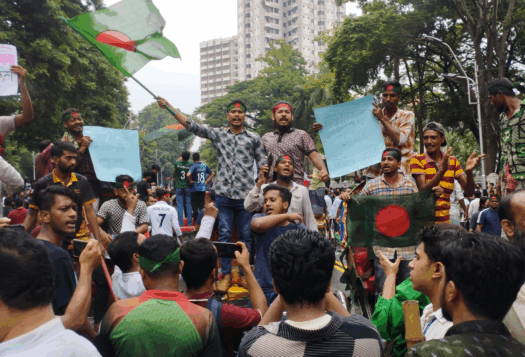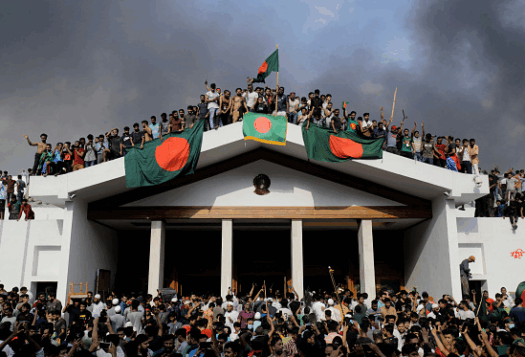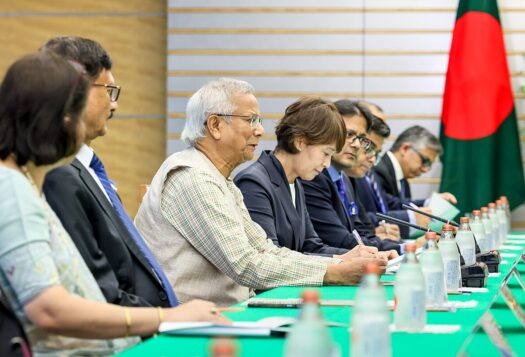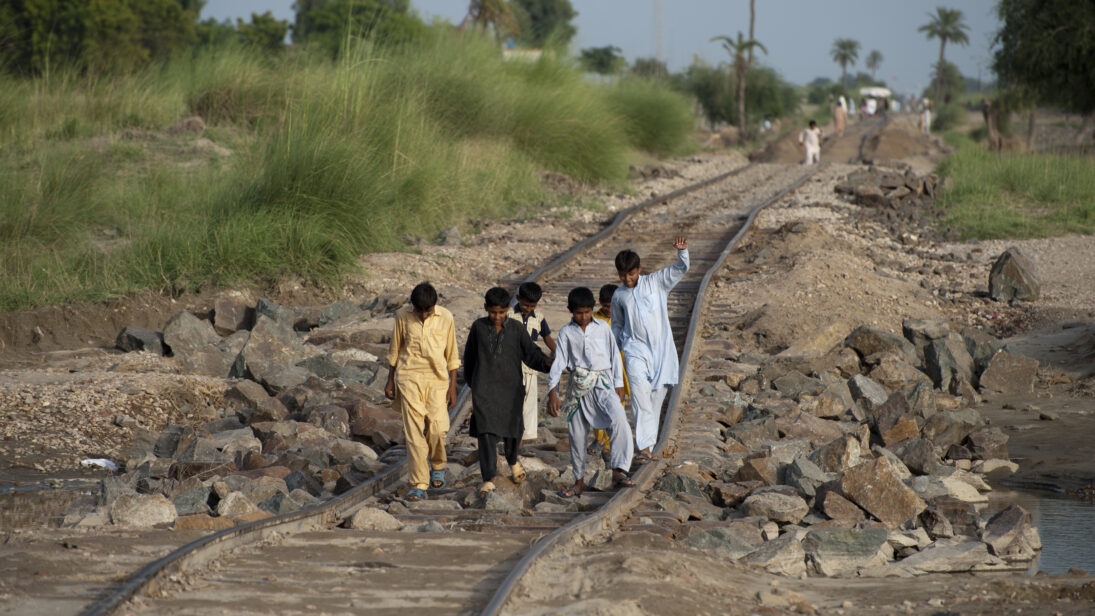
The escalating threat of climate change demands immediate and strategic action in Pakistan. Droughts, floods, and heat waves are leading to increased migration, making people more susceptible to new types of exploitation, including human trafficking. Climate-fueled human trafficking has been surfacing in different parts of Pakistan in more pronounced forms like debt bondage, forced labor, and forced marriages. It is imperative for local law enforcement, community organizations, and government departments to collaboratively strengthen and implement initiatives aimed at preventing climate-induced human trafficking and supporting vulnerable populations.
The Nexus of Climate Change and Human Trafficking
According to the Global Climate Risk Index, Pakistan ranks among the countries most vulnerable to climate change, with devastating floods, droughts, and other extreme weather events becoming frequent. These climate patterns not only multiply powerful social undercurrents like economic inequality, resource scarcity, and poverty, but also lead to other hideous forms of exploitation like human trafficking. UN Office on Drugs and Crime (UNODC) recognizes the fact that climate change compels communities to migrate which in turn makes them vulnerable. Traffickers exploit their vulnerability and coerce them into forced labor or sexual exploitation by capitalizing on their lack of social support, protection, and resources.
These effects have already become apparent in the experiences of communities across Pakistan, particularly in regions like South Punjab and Chitral. In 2010, South Punjab bore the brunt of catastrophic floods, leaving families to deal with the dual burden of poverty and vulnerability. The crops in that region were either destroyed or experienced significant yield reductions. Consequently, these subsistence farmers, facing diminished incomes, fell prey to debt bondage and forced labor. In 2019, glacial lake outburst floods (GLOFs) damaged infrastructure and resulted in the loss of livelihoods. As a result, families became impoverished and forced their young daughters to marry wealthy outsiders in an attempt to alleviate poverty.
These grim episodes underscore the complex nexus between climate-induced vulnerabilities and the exploitation of human lives.
Estimating the Prevalence of Human Trafficking
These grim episodes underscore the complex nexus between climate-induced vulnerabilities and the exploitation of human lives. They also highlight how climate change can be a force multiplier in already vulnerable situations and adds to the insecurity of marginalized groups like women and children. Unfortunately, the interplay between climate and human trafficking is understudied and hard to detect in Pakistan and beyond. While government agencies and relevant ministries focus on the quantifiable economic losses and physical devastation caused by climate change, human security consequences like trafficking often go ignored.
According to the U.S. State Department 2023 Trafficking In Persons Report, various government agencies identified 35,309 victims of trafficking in Pakistan. This number is likely just a fraction of the victims of trafficking crimes because of weak and inadequate detection and reporting mechanisms. The actual number of victims may be much higher, as highlighted by the Global Slavery Index, which estimates 2.3 million victims of modern slavery in Pakistan.
While it is difficult to estimate the number of people falling prey to trafficking as a result of sudden or slow onset climate events, one effort to gauge this potential correlation is to study climate-fueled migration more broadly. Climate migrants are thrust to the margins of society and find themselves three times more vulnerable to trafficking. In Pakistan, organizations like the International Organization for Migration have begun to delve into climate-induced migration but the link to trafficking demands greater scrutiny and targeted interventions.
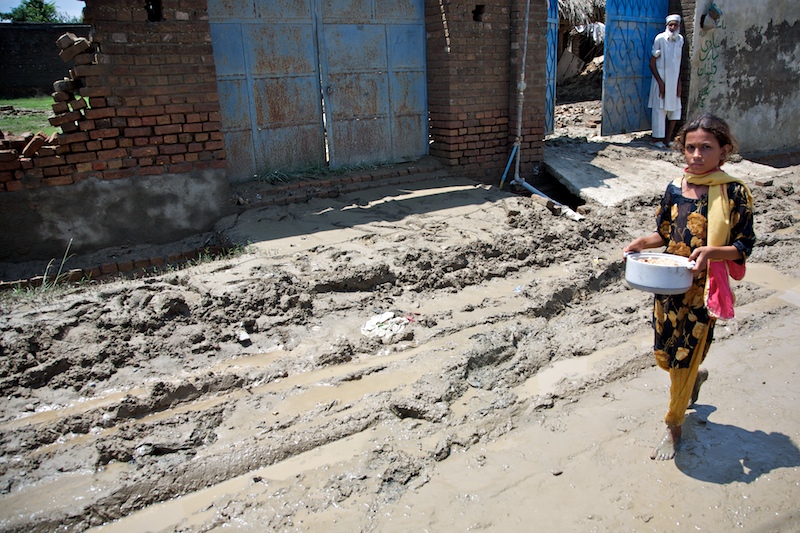
Combating Human Trafficking
Pakistan’s centralized strategy in combating human trafficking, with the Federal Investigation Agency (FIA) leading the charge, has been largely unsuccessful in curbing the issue. This is because human trafficking occurs primarily at the localized and individual level, making district administration and local police departments better suited to support the prevention of trafficking, prosecution of traffickers, and protection of victims.
District police departments are underutilized in terms of efforts against human trafficking, especially in areas affected by calamities. Currently, their responsibilities are limited to prosecuting traffickers, completely overlooking their potential role in preventive measures. These departments, by virtue of their grassroots presence, are best placed to deal with the issue by spearheading prevention efforts through awareness campaigns, community engagement, and watchful oversight. District police departments could initiate this process through several mechanisms, including registering and documenting laborers working in vulnerable sectors such as brick kilns, local factories, and farms in calamity-hit regions. Such a measure would aid in monitoring working conditions and ensuring that workers are not subjected to unlawful practices. Police Khidmat Marakiz or Police Service Centers, due to their widespread national presence, can be effectively employed for this purpose.
Police Service Centers have already laid the groundwork for more inclusive and supportive law enforcement by providing accessible and community-focused services. Expanding the services offered at such centers to tackle issues like forced labor, child labor, and forced begging could significantly bolster the safety of the most vulnerable segments of society. By specifically addressing these issues, the centers would not only provide targeted assistance to individuals at risk of climate-induced exploitation but also act as a bridge between different government departments engaged in both anti-trafficking and environmental disaster measures.
These centers have already facilitated the rehabilitation of drug addicts and imparted skills to marginalized segments of society through effective coordination with other provincial government departments, such as social welfare and education departments. Implementing such initiatives to prevent human trafficking could further position these centers as effective coordination forums available to district authorities.
These departments, by virtue of their grassroots presence, are best placed to deal with the issue by spearheading prevention efforts through awareness campaigns, community engagement, and watchful oversight.
On the detection front, the scope of the recently established organized crime units in Punjab can be broadened to include human trafficking. This strategic enhancement is crucial as it would empower the units to effectively address and disrupt the operations of organized gangs engaged in both human trafficking and smuggling activities. By incorporating human trafficking into their mandate, these units shall be better equipped to identify, investigate, and prosecute networks involved in these illegal enterprises. For victim protection and rehabilitation, empowering District Anti-Trafficking and Anti-Bonded Labour Monitoring Committees is another critical step. These committees can adopt a contextual approach tailored to the nature of the climate event or natural disaster, the types of communities affected, and the infrastructural requirements, which can yield more effective results.
Each natural disaster tends to impact a community in different ways. Strengthening these committees through increased resources, better coordination with law enforcement, and clear mandates could transform them into effective instruments against human trafficking and labor exploitation at the grassroots level. These committees should lead efforts for emergency preparedness, early warning systems, and establishing integrated response mechanisms by coordinating with all the departments responding to disasters. By implementing these measures, Pakistan can improve its response to human trafficking and build a more resilient society that can withstand the challenges posed by climate change.
Also Read: Financing Pakistan’s Climate Adaptation Initiatives
***
Click here to read this article in Urdu.
Image 1: National Food Emergency Response in Pakistan via Flickr
Image 2: Pakistan flood via Flickr
